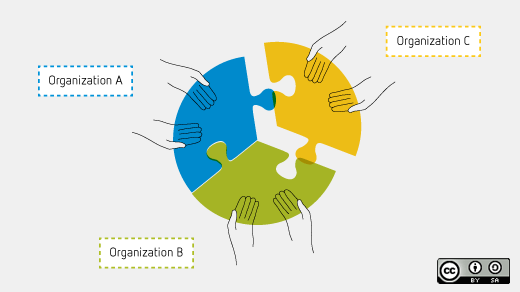We probably all remember the first time we tried open source. Maybe you were peer-pressured, even adventurous. Or maybe you gave it a try only to find someone looking on disapprovingly, and quickly pretended you were doing something else.
My story starts back in an environmental economics course in undergrad. It has nothing to do with software, but an idea called co-production.
Co-production first became a solid term when used by a team of scholars at Indiana University in the early 1970s. They were looking at the provision of public safety by examining the structure and operations of police departments. Key here was their precursor idea demonstrated well before that study: a distinction between the provision of a public good (or outcome) and the production of a service.
Government may be responsible for the provision, or be in charge of it, but it doesn’t have to be the sole producer (the one involved in physically bringing the good into existence). In the case of this public safety study, police performance didn’t vary in expected ways when it came to prime suspects like funding levels. The team suggested the local community was responsible for a lot of producer-like qualities, that in the end, had an effect on the provision of public safety.
It was a new concept, to scholars, at least. They termed it [and this is a later definition] “co-production”—“a process through which inputs used to produce a good or service are contributed by individuals who are not ‘in’ the same organization.”
Here’s the distinction though. We’re not talking “open innovation” where an idea is lobbed by someone outside the walls. These co-producers, are not performing the same task as the organization (otherwise it would just be outsourcing), plus they’re actually doing something. They have something vested in it, and the act of co-producing confers benefits and changes in that person and the community, beyond the immediate effects of the work they contribute.
Sound familiar? We’re talking 1970s here.
In these co-production situations a few maxims stand out: foster more of a peer-relationship instead of a typical client-producer one; be transparent to root out opportunistic behavior; and, make sure as contributions from one side increase, so do those of the other.
Elinor Ostrom, the most well-known of the group, went on to become the foremost expert on managing common pool resources, or environmental commons, a sort of natural extension from public safety. She turned the notion of the tragedy of the commons on its head, extensively highlighting successful forms of community governance.
More recently, she was finally recognized for her work as one of the 2009 winners of the Nobel Prize in economics. This stuff did not catch on quickly and is still relatively unknown in more traditional circles. Landing the Nobel Prize was seen as sort of a coup.
So, here I am, several years prior 2009, sitting through class back in undergrad eating this stuff up, reading every Ostrom or commons-related article I can find.
My roommate at the time was an intern at Center for Strategic and International Studies, working on a version of what is still one of the most comprehensive, if not the only, catalog of governmental policies toward open source.
We talked regularly about our work. In my head, and of course often out loud, I scoffed at the idea of cataloging open source policies, mainly because I didn’t have the faintest idea of why it was interesting or important. All I knew back then was open source equaled nerd (not that environmental economics didn’t of course).
It wasn’t until I finally started to, well, listen, and learn more, that the epiphany happened. The same issues I found so interesting in co-production and management of environmental commons were emerging all over the Internet, in some cases on a much grander scale, and offered a whole new area of study.
Of course, the joke’s on me, now, as the roommate has little to do with open source, and here I am writing on opensource.com.
Although the story is personal, I wonder how many researchers and others have drifted from the environmental field into looking at technology applications and learning new organizational models for governance from open source communities; or, applying the former to improve the latter.
Let’s take Charlie Schweik. I met him a few months ago at a conference, and he (although having actually studied under Ostrom at Indiana) told a similar story of porting the analytical tools of environmental commons to open source. Now he’s been doing some exciting work looking for the first time quantitatively and qualitatively at the life-cycle of open source projects funded through a National Science Foundation Grant.
There’s a lot for open source to learn from this field, and potentially even more for open source practitioners and the field to work together in changing the way public services are “produced.” Some of the more interesting non-software applications of co-production is restorative justice. Next time.

Opensource.com
What to read next



1 Comment